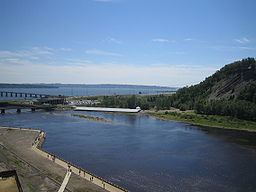- elevation 907 m (2,976 ft) - elevation 31 m (102 ft) Length 101 km Basin area 1,150 km² Mouth Saint Lawrence River | - location Boischatel Discharge 35.6 m³/s Basin area 1,150 km² Province Québec Country Canada | |
 | ||
- location Lac-Jacques-Cartier Unorg. Terr. - average 35.6 m/s (1,257 cu ft/s) - max 580 m/s (20,483 cu ft/s) May | ||
The Montmorency River is a river in the Capitale-Nationale region of Quebec, Canada. It drains into the Saint Lawrence River, about 9 kilometres (5.6 mi) downstream from Quebec City. It is especially known for the impressive Montmorency Falls near its mouth.
Contents
- Map of Montmorency River QuC3A9bec Canada
- GeographyEdit
- TributariesEdit
- HistoryEdit
- Development and useEdit
- FaunaEdit
- References
Map of Montmorency River, Qu%C3%A9bec, Canada
It has an average flow of 35.6 m3/s (1,260 cu ft/s). Typical average summer flow is about 25 m3/s (880 cu ft/s), whereas during spring run-off, the river could swell anywhere from 130 to 650 m3/s (4,600 to 23,000 cu ft/s). Above 770 m3/s (27,000 cu ft/s) is considered an exceptional flood condition, and the Montmorency experienced a record flow of 1,100 m3/s (39,000 cu ft/s) in November 1966.
GeographyEdit
The Montmorency River flows from Lake Montmorency in a southerly direction through the undeveloped Canadian Shield of the Laurentides Wildlife Reserve. Reaching the northern part of the municipality of Château-Richer, it flows between high rocky cliffs that in some places are more than 600 metres (1,969 ft) high. Thereafter, it passes through the municipalities of Sainte-Brigitte-de-Laval, Beauport, and Boischatel, where the course of the river is characterized by the presence of numerous rapids before plunging 83 metres (272 ft) over the Montmorency Falls.
The river's watershed basin is sparsely populated, 92% of it is forested and dotted with 424 lakes. The largest lake, with an area of 7.53 square kilometres (2.91 sq mi), is Snow Lake (Lac des Neiges) which is the source of Neiges River, Montmorency's largest tributary. Urban and agricultural land makes up only 2% and 1% of the basin respectively, and is mostly confined to a small section in the far south of the Saint Lawrence lowlands.
The municipalities and unorganized territories that cover the Montmorency basin are:
TributariesEdit
The larger tributaries of the Montmorency River are (downstream default sorting order):
HistoryEdit
In 1608, Samuel de Champlain visited the falls at the mouth of the river and named it le grand saut de Montmorency ("the great falls of Montmorency") in honour of Charles de Montmorency (1537-1612), to whom Champlain had dedicated his explorations. The name of the falls came to be applied to the whole river, as the 1641 map by Jean Bourdon showed it as "Saut de Montmorency".
French colonization along the Montmorency River initially occurred at the mouth and falls only. The town of Boischatel was settled circa 1664.
In 1759, the Montmorency River formed a major obstacle to English General James Wolfe that prevented him from invading Quebec City from the east and subsequently forced him to scale the cliffs west of the city and battle the French on the Plains of Abraham. Remnants of an earthen fort built by Wolfe can still be found on the east side of the falls.
In the 19th century, colonization and logging of the interior really took off, and settlers came to the Sainte-Brigitte-de-Laval area in 1830. The river was used for log driving and its shores became industrialized when a hydro-electric dam and sawmill were built at the top and foot of the Montmorency Falls respectively. After the logging period ended, textile industry developed at the mouth of the river.
In 1992, the area surrounding the falls and mouth of the river was made into a park and developed for tourism with new viewing platforms, stairs, pedestrian bridge, aerial tram, restaurant, and visitor's centre.
Development and useEdit
There are 48 dams in all on the Montmorency River and its tributaries. Of these, 14 are used to regulate water flow, five to provide drinking water, and only one is used exclusively for hydro-electric power generation. The Hydro-Québec power station at the Montmorency Falls is no longer in operation, but not far upstream is the Marches-Naturelles Hydro-electric Power Station. It has an installed capacity of 4.16 MW.
All municipalities along its course rely on the Montmorency or tributaries for its drinking water supply. Only Sainte-Brigitte-de-Laval treats its waste waters before pumping it back into the Montmorency. Boischatel and Beauport put their waste water into the Saint Lawrence River. The municipalities of L’Ange-Gardien, Château-Richer, Lac-Beauport, Stoneham-et-Tewkesbury do not impact the water quality of the Montmorency since their population centres lie outside the rivers basin, and therefore the water quality is very good.
A total of 76 bridges cross the Montmorency River. Of these, only 3 are public road bridges: Quebec Route 40, Avenue Royale between Beauport and Boischatel, and one at Enchanteresse Island.
FaunaEdit
The four most dominant fish species within the Montmorency basin are the rainbow trout, lake trout, Arctic char, and especially brook trout. Other species include the longnose sucker, white sucker, slimy sculpin, and pearl dace.
There are two species of reptiles: common garter snake and red-bellied snake. In addition, there are eight species of amphibians: American toad, wood frog, green frog, spring peeper, red-backed salamander, dusky salamander, northern two-lined salamander, and eastern newt.
